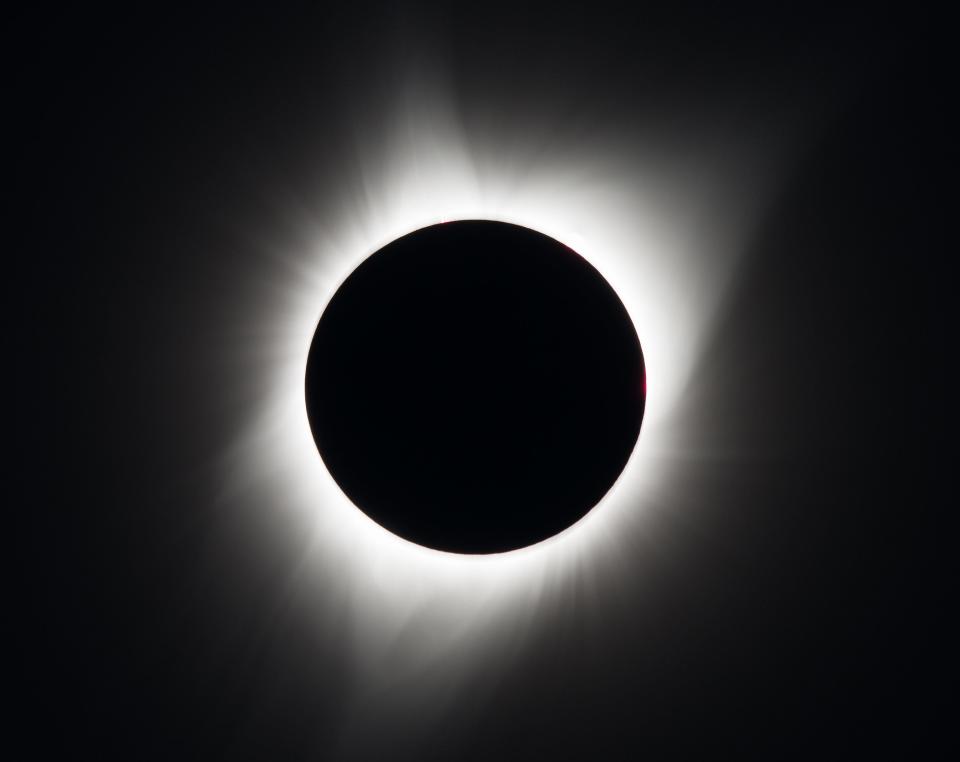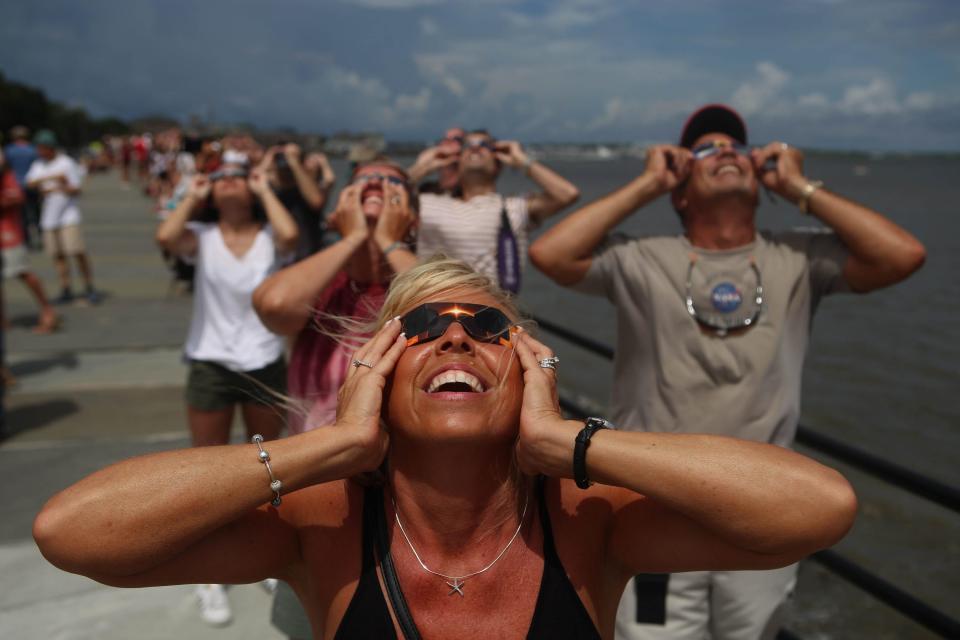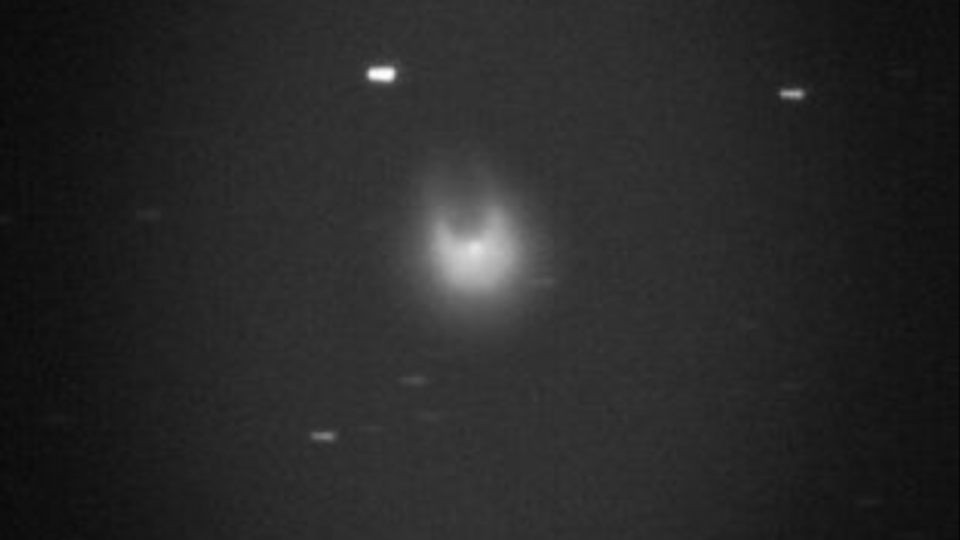2024 total solar eclipse is Monday: What to know less than a week out
Editor's note: An updated cloud forecast for the April 2024 total solar eclipse is in. Read the latest eclipse forecast and news as of Wednesday, April 3.
The 2024 total solar eclipse is now less than one week away, and forecasters are getting a clearer picture of what the skies will look like. It's not all good news for people who want to see the spectacle.
On Monday afternoon, April 8, a total eclipse of the sun will cross over a dozen states as it traverses from Texas to Maine. Millions of people are expected to travel to see it.
The full total solar eclipse experience will plunge people along a narrow path into darkness midday, but people outside the path of totality can still use eclipse glasses (maybe free eclipse glasses) to see the moon pass in front of the sun — if it's not blocked by clouds.
Meanwhile, those planning to order glasses online may be rapidly running out of time to do so in order to have them delivered on time.
Here's the latest weather forecast for the day of the eclipse:
A grim forecast for Texas
Unfortunately, the weather is looking iffy for folks in some places, especially Southern areas: The cloud cover forecast "shows fairly high probability of clouds in Texas up through the Mississippi Valley," wrote meteorologist Matt Lanza on his blog The Eyewall.
The National Weather Service in Dallas said there's only a dismal 15% chance for favorable viewing conditions in Dallas on April 8. "The outlook for favorable viewing conditions continues to deteriorate as the event approaches," the weather service said.

Indeed, the computer models that meteorologists use to forecast weather show a grim forecast for Texas: "The operational runs of both the GFS and European models have, consistently, shown nearly 100 percent cloud cover across much of the state during the early afternoon hours on Monday," said Eric Berger, a Houston-based meteorologist on the blog Space City Weather.
Another forecaster, Marc Chenard of the Weather Prediction Center, confirmed the gloomy forecast to USA TODAY: "Cloud cover is most likely in Texas, Oklahoma and Arkansas," he said. In fact, "varying degrees of cloudiness" are likely all the way to the Ohio Valley, he said.

Could there be storms on Monday?
Monday may not only be cloudy in some areas, it could also be stormy, forecasters said: "At this time, specifics about hazardous weather are unknown," the Weather Prediction Center said. "However, rain and thunderstorms do appear possible in and near the path of totality in Texas, southeast Oklahoma, and Arkansas."
Where is the best chance for clear skies for the total eclipse?
For the total eclipse, the best chances for clear conditions are in New England and upstate New York, Chenard told USA TODAY.
"If I’m picking a place right now, it’s probably like Watertown, New York," Lanza said.
The National Weather Service in Buffalo is also bullish on the chances for good weather, with a caveat: The forecast continues to suggest dry weather for Monday with high pressure over the eastern Great Lakes and Ohio Valley, "however it is FAR too early to forecast cloud cover with any confidence or reliability," the weather service wrote in its forecast discussion.
Ironically, the prediction of clouds in Texas and clear skies in the Northeast are the opposite of historical trends for cloud cover.
Where is the cloud forecast best for the partial eclipse?
There will also be ample opportunities for folks to view the partial eclipse: "The best locations for viewing can be the Southwest and the East, especially east of the Appalachians," AccuWeather lead long-range forecaster Paul Pastelok said. "Cities like El Paso, Albuquerque, Philadelphia, Washington D.C., New York City and Raleigh should all have great views."
Although not in the path of totality, regions in the Southwest also look to have ideal weather.
"The area from West Texas to southern Arizona should also have favorable viewing conditions," Pastelok added. "These areas will be close to the path of totality with the least amount of cloud cover anticipated."
Order eclipse glasses online now to have them delivered on time
If you're buying your specs through American Paper Optics, the nation's largest supplier of eclipse glasses, the company makes it easy for you with a countdown at the top of its website for how much longer you have to procrastinate. As of Tuesday morning, customers have little more than three days to make their purchase and take advantage of the company's express shipping across the country.
That's about the same amount of time allotted to Walmart+ online shoppers, as well as Prime members looking for reputable glasses on Amazon.
Many eclipse websites like GreatAmericanEclipse.com and NationalEclipse.com also sell a variety of eyewear products, along with plenty of other gadgets — but double check that estimated delivery date before checking out.
How do I watch the 2024 solar eclipse, if clouds don't block it?
There are a few ways of watching the eclipse:
Get the full experience in person: If you're in a narrow band of U.S. land that spans from Texas to Maine, you could see the moon block the sun and its shadow cast a night-like darkness over Earth for a few minutes. You could briefly be able to look up without eye protection and see the moon block the sun.
Watch from outside the path of totality: Much of the U.S. could get a partial view of the eclipse that isn't nearly as impressive as being in the path of totality. Earth won't be plunged into complete darkness and you'll have to wear protective eyewear to see the moon partially block the sun.
Watch a livestream: Check back on April 8 for a video feed from the path of totality. It's not the same as being there in person, but hey, at least you won't have to sit in traffic.
What time is the solar eclipse on April 8?
The eclipse will begin in Texas at 1:27 p.m. CDT and end in Maine at 3:35 p.m. EDT, but the exact time of the eclipse varies by where you are in its path.
Here are the major cities in each state where you can expect to experience totality (note that the included times do not account for when the partial eclipse begins and ends):
Dallas, Texas: 1:40-1:44 p.m. CDT
Idabel, Oklahoma: 1:45-1:49 p.m. CDT
Little Rock, Arkansas: 1:51-1:54 p.m. CDT
Poplar Bluff, Missouri: 1:56-2:00 p.m. CDT
Paducah, Kentucky: 2-2:02 p.m. CDT
Carbondale, Illinois: 1:59-2:03 p.m. CDT
Evansville, Indiana: 2:02-2:05 p.m. CDT
Cleveland, Ohio: 3:13-3:17 p.m. EDT
Erie, Pennsylvania: 3:16-3:20 p.m. EDT
Buffalo, New York: 3:18-3:22 p.m. EDT
Burlington, Vermont: 3:26-3:29 p.m. EDT
Lancaster, New Hampshire: 3:27-3:30 p.m. EDT
Caribou, Maine: 3:32-3:34 p.m. EDT
Will clouds really ruin the eclipse?
Clouds are just part of weather, and as noted in the latest forecast, it's likely that some of the millions of people in the path of totality for April's total eclipse will have to endure overcast skies that will impact the experience.
But determining how clouds would change your view depends on the types of clouds – and which expert you ask. Some advise eclipse watchers to not worry about the skies, others say an overcast sky can ruin the experience.
Before last year's annular solar eclipse, National Weather Service meteorologist Tim Daldrup told Oregon Public Radio that if clouds are in the forecast, you should hope for the "right kind of clouds."
“If we want to see it, we’ll want the higher-level clouds,” Daldrup told OPR. “Those tend to be the more feathery cirrus clouds that can still be seen through. They might obstruct the eclipse but you can still see it.”
Cirrus clouds would be in contrast to some of the more eclipse-unfriendly clouds, such as a thick deck of lower-level stratus or cumulus clouds that would likely completely block the sun.
New York inmates say a prison lockdown for the eclipse violates religious freedom
Inmates at a New York prison who are being prevented from witnessing next week's total solar eclipse have filed a lawsuit against the state corrections department, claiming that the decision violates their religious freedoms.
The celestial phenomenon, which has not passed over New York since 1925 and will not be seen again in the state until 2079, "is a significant religious event for people of many different faith backgrounds," according to the complaint, which was filed Friday in federal court in upstate New York.
However, New York corrections officials put a lockdown in place at its facilities for April 8, the day the eclipse will pass over a long stretch of North America, including New York, as the moon blots out the sun. Among them is the Woodbourne Correctional Facility, the prison in Woodbourne where six men of varying religious faiths jointly sued the corrections department over the policy.
The plaintiffs – a Baptist, a Muslim, a Seventh-Day Adventist, two practitioners of Santeria and an atheist – are asking a judge to order the corrections department to immediately rescind the lockdown memo and provide eclipse glasses to all inmates who wish to view the eclipse, as it did when a partial eclipse was visible in 2017 in New York.
"This should not be controversial and was previously allowed during the last solar eclipse viewable in New York State," the lawsuit stated, arguing that the lockdown is unconstitutional.

'Devil' comet to make an appearance this month
As if a solar eclipse weren't enough, observers on April 8 may also get a glimpse of a rare "horned" celestial show, a dazzlingly bright comet with a scary name.
A comet designated 12P/Pons-Brooks got the much more interesting name “devil comet” when it had an outburst, a large ejection of dust and gases, in July 2023.
On the day of the Great American Eclipse, the devil comet may become visible to the unaided eye, astronomers say.
Amateur and professional observers in the Northern Hemisphere will get a unique opportunity to view the comet, which is renowned for its periodic eruptions of gas and dust.
This article originally appeared on USA TODAY: 2024 total eclipse news and forecast for Tuesday, April 2
